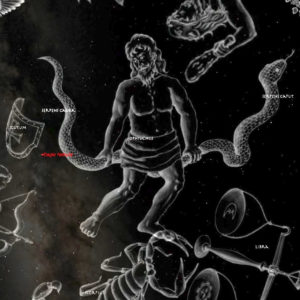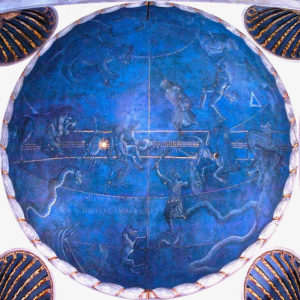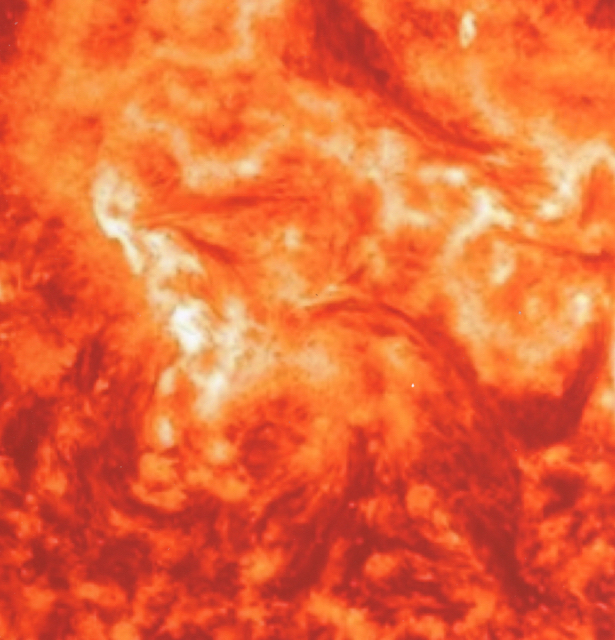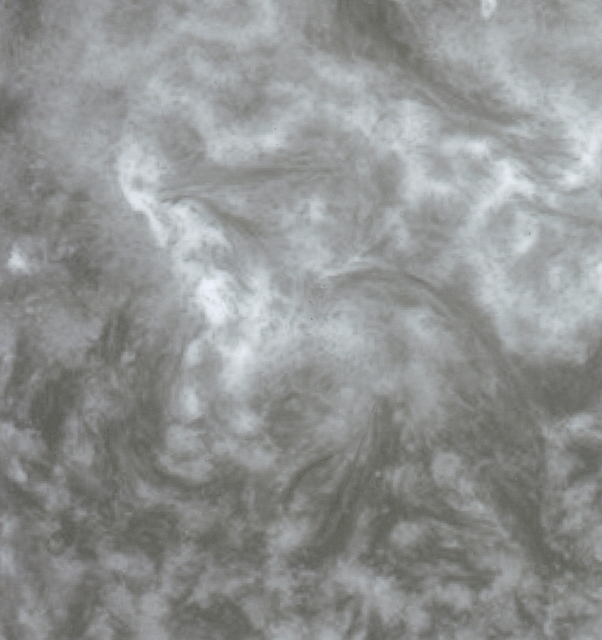Star Queen Nebula
and Heart of the Sun
Image Credit & Copyright: Dieter Willasch (Astro-Cabinet.com)
This beautiful upturned face with closed eyes and pursed mouth is actually a massive cluster nebulosity and diffuse part of an emission nebula or H II region. This type of nebula tends to be red because of the abundance of hydrogen. The face of this nebula, known as M16, lies at a distance 6,500 light years from Earth and spreads over 720 trillion miles. It’s mind-boggling to imagine that a gaseous cloud, stretched across the vast expanse of space, hundreds of trillions of miles wide, could create and hold in perfect proportion, a recognizable, profiled face of such beauty and accuracy. Such a face could be known as a celestial-coccygia, an image perceived in a cloud of stars. This cluster is estimated to be between one and two million years old.
STAR QUEEN
The Eagle Nebula and Swan Nebula are found here together as M16 and M17. The name given to the nebula reflects impressions of its shape. Robert Burnham, Jr. introduced a most appropriate name for this area–the “Star Queen of the Eagle Nebula.” The nebula’s face has 8,100 stars and is found within the Constellation of Serpens Cauda-Tail of the Serpent.
Many cultures knew the Milky Way as the Great Serpent, the Cosmic Womb, and the Mother of the Universe. Cultures near or below the equator, Peru for example, perceive the ‘dark constellations’ in the Milky Way rather than those that are seen as starlight. These dark constellations are known by names like Mach’acuay–the Great Serpent.
EAGLE NEBULA & EARTH PLACEMENT
The celestial Eagle Nebula above at 13°50’563”N, passes directly over the terrestrial lands of the Machu Picchu area, as well as Angkor Wat, the Niger Delta, the Philippines, and Mali. Each of these earth latitudes have the same celestial latitude of the Eagle Nebula 13°50’563”N. The ancients believed these alignments to be mirrors of each other and places of great power.
An example of this alignment is the Temple of Angkor Wat. Built in 10,500 BC, its structures mirrored the same coordinates and star patterns seen above, creating a powerful alignment below. Some theories suggest that as the progressing star system moved on, the temples were abandoned and fell into disarray.
There was a time in history when the construction and placement of a temple, church, government or sacred site, was chosen to harmonize with a specific season and passing constellation. As an example, many of the older churches in Italy recorded both the celestial/terrestrial alignment of their cathedrals in their ornate inner domes. These domes recorded the celestial charts of the heavens, marking the day and year of the consecration of each church, thereby anchoring heaven to earth. The Sacristy Dome of San Lorenzo in Italy was consecrated in 1429 on the Solstice. Here Gemini and Orion crown the zenith moment of its dedication.
SPIRITUAL HEART OF THE SUN
- On June 7th, 2011, NASA captured this image of the Sun. It was reported to be one the largest Coronal Mass Ejections ever recorded at the time. Interestingly, though NASA addressed the explosion, it did not address the visibly bright, clear image located at the very heart of the Sun. So I began my own research.
The image, in both color and black/white, revealed the peaceful face of what appears to be a spiritual being near the center of the sun. His beautiful countenance on the sun’s fiery surface is astonishing as is the “bindi” he wears on his forehead and his broad bare shoulders. He gazes downward and his heart is red with fire and surrounded by rays of light.
Given the traditional bindi on his forehead, I assumed he was from India. Therefore I began my search to locate a Hindu name that meant spiritual heart of the sun. It took only a few minutes of research until I found the name Gayatri, a Sanskrit word that literally translates as Spiritual Heart of the Sun. How perfect!
The appearance of this face of fire and light was visible well before the CME (coronal mass ejection) explosion and remained long after it disappeared. What are the odds that an image of art, created from molten fire and light, could hold its liquid and gaseous fires in place, continually gaining clarity and remaining recognizable for over 3.5 minutes? By comparison, the massive CME explosion on the right side of the Sun that NASA watched…was over in less than 24 seconds.
The Gayatri Mantra is also known as the Savitri mantra, a highly revered mantra dedicated to Savitr, the Sun deity. Its recitation is preceded by OM and is known as the “great mystical utterance.”
Our galactic central sun continually vibrates OM according to the Upanishads, the sacred Hindu writings. Through establishing a profound affinity with the sun through a lifetime of the OM mediation, one easily passes upward and through the sun. www.agarthanalliance.blogspot.com
- “Spiritual Heart of the Sun – O Thou, Who gives sustenance to the universe, from Whom all things proceed, to Whom all things return, unveil to me the true Spiritual Sun hidden by a disc of Light that I may know the Truth and complete my full calling as I journey to Thy sacred feet.” -Gayatri Chant
- Image Credit & Copyright: Dieter Willasch (Astro-Cabinet.com) Permission granted to earthsmajesticlandscapes.com
- Image Credit: NASA, ESA, and Hubble Heritage Team (STScI/AURA, Acknowledgment: T. Do, A.Ghez (UCLA), V. Bajaj (STScI)
- Image from my Starry Night Program
- Sacristy Dome of San Lorenzo, Italy. Photographer Filippo Brunelleschi. Permission granted.
- August 2005; taken from helicopter over Anghor Wat by Charles J Sharp
- All three Images from NASA. Public Domain.







